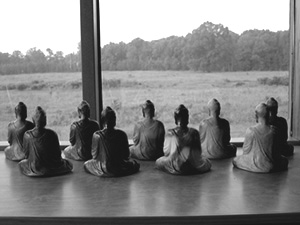Myth and Legend
It is not possible to get a historically accurate picture of the Buddha, his early followers, or the early ancestors of Zen. What we have is a collection of stories, some of which may closely resemble actual events and many which strike the contemporary imagination as complete fantasies. However, these stories convey important teachings and continue to guide our practice even though they may be “myths,” for this is one of the functions of a myth—to convey a deep truth in the form of a story that may or may not be literally true.
The most distinctive myth in Zen is the myth of the transmission; no other form of Buddhism has it. Through this myth, Zen tells of its origins and asserts that its teachers have transmitted a practice that conveys the essence of Buddhism. It asserts that Zen’s origins are not in China as the historians claim, but in India with Shakyamuni Buddha himself, and every certified teacher of Zen Buddhism is directly connected to him through an unbroken line of practitioners, in a chain known as the lineage. According to this well-known story:
 Once, when the Buddha was gathered with his followers on Vulture Peak, the god Brahma presented him with a bouquet of flowers and asked him to expound on the Dharma. The Buddha said nothing, but took one of the flowers and twirled it. Of all his followers only one disciple, Mahakashyapa, understood the significance of this gesture. The Buddha recognized that Kashyapa understood and said, “I have the Treasury of the Eye of the True Dharma and Wondrous Mind of Nirvana, and I transmit it to Mahakashyapa.”
Once, when the Buddha was gathered with his followers on Vulture Peak, the god Brahma presented him with a bouquet of flowers and asked him to expound on the Dharma. The Buddha said nothing, but took one of the flowers and twirled it. Of all his followers only one disciple, Mahakashyapa, understood the significance of this gesture. The Buddha recognized that Kashyapa understood and said, “I have the Treasury of the Eye of the True Dharma and Wondrous Mind of Nirvana, and I transmit it to Mahakashyapa.”
Zen holds that this “treasury of the eye of the true dharma” has been passed on, master to disciple, teacher to student, mind to mind, since that time. The transmission of this treasury cannot be adequately conveyed in words, but is something that is deeply experiential and uniquely personal, as evidenced by the great variety of transmission stories. In these stories events such as a pebble hitting a tile, a monk stubbing his toe, or a master lifting a single finger have triggered realization. Of course, this claim of person-to-person transmission cannot be historically verified and is almost certainly not literally true, especially of the transmission in India, where it represents more of a “spiritual ancestry” than an accurate historical record.
The Indian part of the lineage includes figures whose teachings were important in the evolution of Zen. For example, it includes Nagarjuna, a major contributor to the Madhyamika school of Mahayana Buddhism and Vasubandhu, who helped establish the Yogachara school, as Zen ancestors, although very few scholars would say that what they taught and practiced was “Zen.” At some point, probably in China, the lineage does become an accurate historical record, although it is debatable exactly where that point is.
